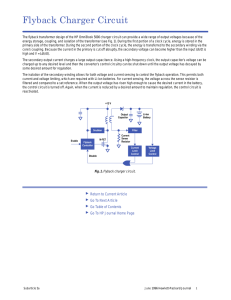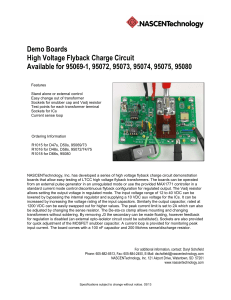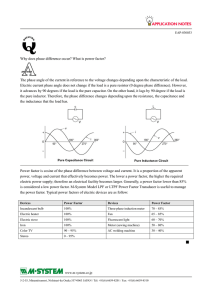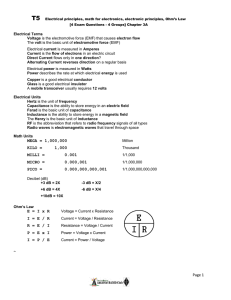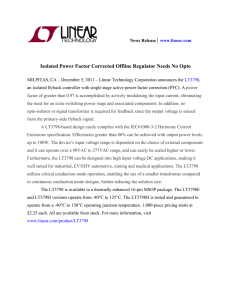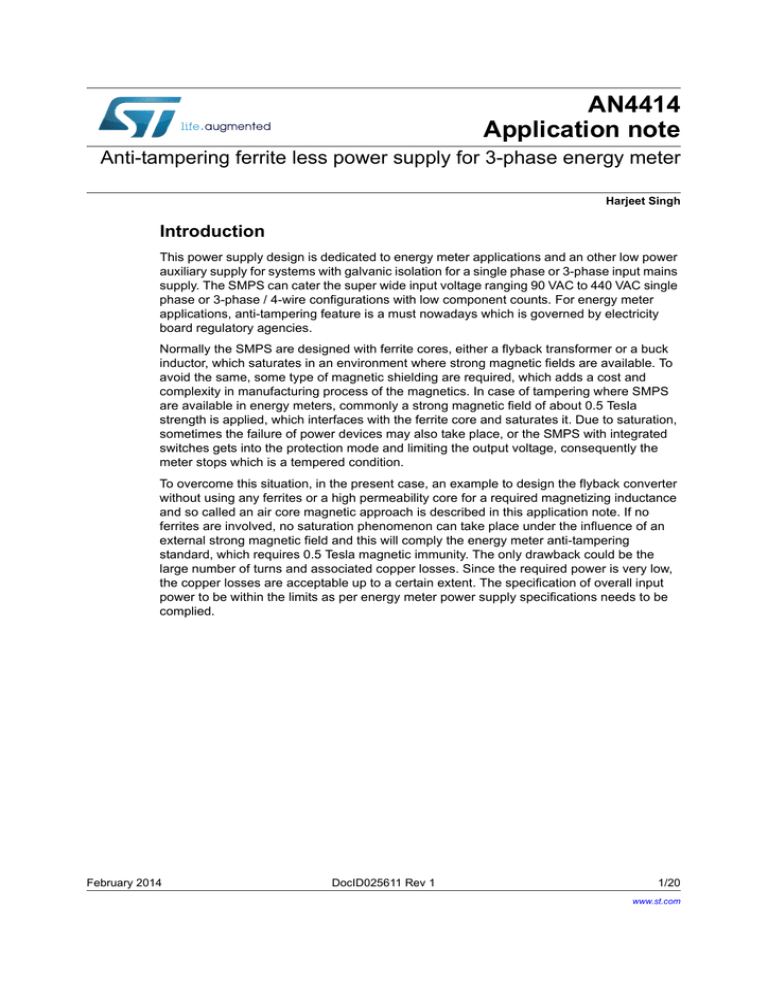
AN4414
Application note
Anti-tampering ferrite less power supply for 3-phase energy meter
Harjeet Singh
Introduction
This power supply design is dedicated to energy meter applications and an other low power
auxiliary supply for systems with galvanic isolation for a single phase or 3-phase input mains
supply. The SMPS can cater the super wide input voltage ranging 90 VAC to 440 VAC single
phase or 3-phase / 4-wire configurations with low component counts. For energy meter
applications, anti-tampering feature is a must nowadays which is governed by electricity
board regulatory agencies.
Normally the SMPS are designed with ferrite cores, either a flyback transformer or a buck
inductor, which saturates in an environment where strong magnetic fields are available. To
avoid the same, some type of magnetic shielding are required, which adds a cost and
complexity in manufacturing process of the magnetics. In case of tampering where SMPS
are available in energy meters, commonly a strong magnetic field of about 0.5 Tesla
strength is applied, which interfaces with the ferrite core and saturates it. Due to saturation,
sometimes the failure of power devices may also take place, or the SMPS with integrated
switches gets into the protection mode and limiting the output voltage, consequently the
meter stops which is a tempered condition.
To overcome this situation, in the present case, an example to design the flyback converter
without using any ferrites or a high permeability core for a required magnetizing inductance
and so called an air core magnetic approach is described in this application note. If no
ferrites are involved, no saturation phenomenon can take place under the influence of an
external strong magnetic field and this will comply the energy meter anti-tampering
standard, which requires 0.5 Tesla magnetic immunity. The only drawback could be the
large number of turns and associated copper losses. Since the required power is very low,
the copper losses are acceptable up to a certain extent. The specification of overall input
power to be within the limits as per energy meter power supply specifications needs to be
complied.
February 2014
DocID025611 Rev 1
1/20
www.st.com
Contents
AN4414
Contents
1
Description of SMPS . . . . . . . . . . . . . . . . . . . . . . . . . . . . . . . . . . . . . . . . . 3
1.1
Basic flyback equations . . . . . . . . . . . . . . . . . . . . . . . . . . . . . . . . . . . . . . . 5
1.2
Anti-tampering requirement . . . . . . . . . . . . . . . . . . . . . . . . . . . . . . . . . . . . 7
1.3
Calculations . . . . . . . . . . . . . . . . . . . . . . . . . . . . . . . . . . . . . . . . . . . . . . . . 9
2
Reference . . . . . . . . . . . . . . . . . . . . . . . . . . . . . . . . . . . . . . . . . . . . . . . . . 19
3
Revision history . . . . . . . . . . . . . . . . . . . . . . . . . . . . . . . . . . . . . . . . . . . 19
2/20
DocID025611 Rev 1
AN4414
1
Description of SMPS
Description of SMPS
The front-end of the power supply comprises of a surge suppressor, rectifiers and
a MOSFET as a series regulator. The 3-phase, 4-wire bridge rectification scheme is
adopted so as to run the system in case of neutral missing. The input side is protected
against spikes using suitable varistors. Then EMI filter is connected across the DC using an
undamped LC filter (L1, C8 and C11) for both the common mode and differential mode
suppression. The purpose of the voltage clamping circuitry is to protect the flyback stage
against overvoltages for a better reliability and it comprises of an N-channel 2 /600 V
MOSFET Q1 and a self driven control circuit. The NTC limits the inrush current. The Zeners
D5 and D6 regulate the DC bus to the input of the buck stage to about 345 - 350 VDC, while
resistors R2, R5 and R7 provides enough of gate-source charge.
The flyback converter is built using an integrated power device - the VIPER17, one of the
devices from the VIPer® plus family. Some of the device features are listed below:
800 V avalanche rugged power section
PWM operation with frequency jittering for low EMI
Operating frequency:
–
60 kHz for L type
–
115 kHz for H type
Standby power < 50 mW at 265 VAC
Limiting current with adjustable set point
Adjustable and accurate overvoltage protection
Onboard soft-start
Safe autorestart after a fault condition
Hysteretic thermal shutdown
The device is available in DIP-7 and SO-16 narrow packages as shown in Figure 1.
Figure 1. DIP-7 and SO-16 narrow package
Table 1. Typical power capability of VIPER17
Part number
VIPER17
230 VAC
85 - 265 VAC
Adaptor(1)
Open frame(2)
Adaptor(1)
Open frame(2)
9W
12 W
5W
7W
1. Typical continuous power in non ventilated enclosed adapter measured at 50 °C ambient.
2. Maximum practical continuous power in an open frame design at 50 °C ambient, with adequate heat
sinking.
DocID025611 Rev 1
3/20
20
Description of SMPS
AN4414
The DC output voltage from the clamp circuit is filtered using a 4.7 µF capacitor C10 and
supplied to the drain pin of the device. The VCC of the device is supplied through an
auxiliary winding of the transformer (pins 1 - 2) and filtered by the capacitor C9. A
decoupling capacitor can also be connected to the VCC pin for noise suppression. On the
primary side of the transformer RCD clamp is being used using the R3, C3 and D3 to keep
the leakage spike as low as possible. The feedback to the device is provided using the
optocoupler U2 and TL431, U3 at the secondary side of the transformer. The voltage divider
network R11 and R12 provides 2.5 V reference to the pin1 of the TL431. The power supply
is designed for 5 V at 100 mA. The transformer primary inductance is sized to limit the peak
current through the device below the maximum level. The output DC is filtered using low
ESR capacitors C4 and C5. A post LC filter is also used to further scale down the ripple
voltage to get ultimate 5 V output required for the microcontroller and other circuitry in the
energy meter.
Some of the features of the VIPER17 like “BR” and “CONT” are not used here as the
objective is to analyze the VIPER17 application with the air core transformer. Briefly these
functions are explained below (Refer to the VIPER17 datasheet for more information on BR
and CONT features):
BR: the input voltage information is provided to the BR pin by using the resistor divider
network from rectified bus voltage and can detect the brownout threshold to turn off the
device. The resistor divider network R15, R16, R17 and R18 are programmed to
achieve brownout protection.
CONT: with the CONT pin, one can impose a limit on the peak drain current (Idlim can
be programmed using the R14) and another feature is to have protection in case output
overvoltage (output OVP protection), which can be sensed using the auxiliary winding
which is used for VCC biasing.
Table 2. Specification of SMPS
4/20
Parameters
Limits
Input voltage range
90 - 440 VAC, 3-phase, 4-wire
Input supply frequency
50 Hz
Input / output isolation
Yes
Output voltage/current
5 V/100 mA
Total output power
0.5 W
Application/load
Metering, auxiliary power supply
Output voltage ripple
<100 mV (pk-pk)
Power factor correction
No
Topology/ devices
Flyback VIPER17HN, STD4NK60Z
DocID025611 Rev 1
AN4414
1.1
Description of SMPS
Basic flyback equations
Generally the flyback design calculations are as below:
Equation 1
As we know:
di
V = L ----dt
Equation 2
Rewriting as below:
Ipkp
Vdcmin = Lp -----------Ton
where:
Vdcmin = minimum DC input to flyback converter
Ipkp = peak primary current
Ton = turn-on time of primary switch (VIPer in this case).
Equation 3
Ton = Dmax Ts
Equation 4
Dmax
Ton = ---------------fsw
where:
Dmax = maximum duty cycle
fsw = operating switching frequency of converter.
Equation 5
Ipkp fsw
Vdcmin = Lp ---------------------------Dmax
Equation 6
Vdcmin Dmax
Ipkp = -------------------------------------------Lp f sw
As we know, power = energy transferred x frequency.
Equation 7
2
1
Pin = --- Lp Ipkp fsw
2
where Pin = input transformer power.
DocID025611 Rev 1
5/20
20
Description of SMPS
AN4414
The primary inductance is calculated as:
Equation 8
2 Pin
Lp = -----------------------------2
Ipkp fsw
Equation 9
Pout
Pin = ------------
where:
= efficiency of flyback stage
Pout = output power required.
Equation 10
2 Pout
Lp = ---------------------------------------2
Ipkp fsw
Using Equation 10, we can rewrite Equation 6 as:
Equation 11
2 Pout
Ipkp = ---------------------------------------------------- Vinmin Dmax
Reflected voltage is defined as:
Equation 12
Dmax
VR = ------------------------------ Vdcmin
1 – Dmax
RMS primary current is:
Equation 13
Dmax
Iprms = Ipkp ---------------3
Turn ratio, n is defined as:
Equation 14
VR
Np
n = --------------------------- = -------Vout + VF
Ns
where:
Np = number of primary turns
Ns = number of secondary turns.
6/20
DocID025611 Rev 1
AN4414
1.2
Description of SMPS
Anti-tampering requirement
The E-meter SMPS requires a 0.5 T external magnetic immunity test and generally ferrites
saturated with a 0.5 T external magnetic field. In order to comply this norm, a lot of attention
is required in making proper shield transformers, which is very expensive and sometimes
still difficult to comply the norms easily. The alternative to this is to adapt a ferrite less or air
core transformer approach for such low power output requirement.
Considering the classical equations for a DCM (discontinuous conduction mode) flyback
converter as described in Section 1.1: Basic flyback equations will result in a higher
magnetizing inductance of primary of transformer. So using no ferrite material (we call this
as “Air core”) to build the high frequency transformer would result in higher number of turns
to achieve the required magnetizing inductance and with air core, the primary inductance in
the range of 1 mH is itself difficult to achieve with reasonable number of primary turns.
So the first most important criterion to this approach is to select a low primary inductance
value, Lp, but the value must be greater than a threshold in order not to cause an excess
peak drain current. The high voltage flyback switcher is specified with a finite peak current of
MOSFET, depending on its Rds_on and thermal dissipation. Considering the VIPER17 family
devices, we have this current as: Idlim = 0.4 A.
So during the wide mains operation, the peak primary current should be well below this
value to avoid any protection to activate in a nominal operation. The VIPER17 has a hiccup
mode activation above this current level.
As we know, the important parameters for a flyback design are:
Dmax = max duty cycle,
VR = reflected voltage,
Lp = primary inductance,
n = turn ratio, np/ns
Ipkp = peak primary current
fsw = switching frequency
Equation 15
Primary turns
Lp Ipkp
Np = -----------------------------Bmax Ae
where:
Ae = cross-sectional area of core chosen
As we know, selecting higher duty cycle will have below impact:
Equation 16
DocID025611 Rev 1
7/20
20
Description of SMPS
AN4414
This clearly states that selecting a higher duty cycle at a minimum input voltage will cause
the peak primary current to decrease and requires a high magnetizing inductance. To attain
the required inductance, we will require a larger number of turns and the transformer would
be very bulky if no high permeability ferrite material is used to require that inductance.
Moreover the DCR of windings will increase due to a long wire length and copper losses will
be more, impacting the efficiency and metering standard norms. For 3-phase metering, the
power supply consumption should be limited below 8 VA.
Looking into the above challenges, we need to define a very low value of a maximum duty
cycle and hence the peak primary (or drain current) at somewhat higher value. On the other
hand, this would require lesser turn ratio (n) and there would be a large number of
secondary turns in comparison with a traditional flyback transformer.
Note:
8/20
Maximum primary peak (or a drain current of the device) < Idlim (maximum specified value
in the VIPER17 datasheet).
DocID025611 Rev 1
AN4414
Description of SMPS
As we know from Equation 10:
2 Pout
Lp = ---------------------------------------2
Ipkp fsw
that is:
Equation 17
1
Lp --------fsw
or
1
Lp ---------------Bmax
So one can use a higher switching frequency of the operation to maintain a lower
inductance and hence a lower number of primary turns.
STMicroelectronics® has the VIPER17H for 115 KHz and the VIPER17L for 60 KHz
operation.
Select VIPER17H for this application.
1.3
Calculations
Input voltage to converter: 80 V to 265 VAC
Maximum withstanding voltage: 440 VAC line-line.
Output voltage: Vout = 5 V
Maximum output current: Iout = 100 mA
Equation 18
Pout = Vout x Iout
The typical power stage to withstand this wide mains operation is to clamp the DC bus
voltage to the flyback stage at a lower level. This can be achieved by using a MOSFET and
a Zener clamp circuit as a front-end stage as shown in the schematic in Figure 9 on
page 17. This approach is a simple series pass regulator and well acceptable as we are
dealing with a very low power output requirements. The DC input to the flyback stage
doesn't exceed the voltage at which the Zener clamp network starts conducting and any
further increase in an input rectified voltage will drop across the series MOSFET. Since the
current in the MOSFET is very small, we can select a D2PAK package in order to dissipate
the heat on the copper area provided in the printed circuit board.
Minimum DC bus voltage at flyback input:
Equation 19
Vdcmin ~ 100 VDC.
DocID025611 Rev 1
9/20
20
Description of SMPS
AN4414
Maximum DC bus voltage at flyback input:
Equation 20
Vdcmax ~ 360 VDC
Assuming efficiency, = 65 % (flyback stage):
Equation 21
fsw = 115 KHz
Equation 22
1
Ts = --------- = 8.69s
fsw
Equation 23
Let
VR = 10 V
Equation 24
Dmax
VR = ------------------------------ Vdcmin = 10V
1 – Dmax
Equation 25
this gives
Dmax = 9.1%
Ton = Dmax = 790 µs
Which is greater than Tonmin (= 400 ns), the device minimum turn-on time as per the
datasheet of the VIPER17HN.
Equation 26
2 Pout
Ipkp = ----------------------------------------------------- = 0.169A
Vinmin Dmax
Where the max. drain current limitation threshold of the VIPER17 is 400 mA, so at minimum
DC input voltage, the device will not enter into the hiccup mode.
Equation 27
2 Pout
Lp = ---------------------------------------- 540H
2
Ipkp fsw
10/20
DocID025611 Rev 1
AN4414
Description of SMPS
Case 1
Assuming Lp = 400 µH
Equation 28
as
VR = 10 V,
so
Equation 29
VR
n = --------------------------- = 2 (ignoring VF)
Vout + VF
Np is two times of Ns.
Using a lesser diameter wire (DCR will obviously be high, but select in order to have
it < 10 E in any case to avoid copper losses), a large number of turns can be accommodated
in the available bobbin. Here we can consider the EE19 bobbin. Common practice to fix this
type transformer specification is to wound primary turns as a selected AWG wire on the
bobbin till the required inductance (Lp) is not achieved. Freeze Np at desired Lp. Select
secondary turns, Ns = Np / n and auxiliary turns to maintain a minimum VCC bias voltage to
the device.
With Lp = 400 µH and Pout = 0.5 W in Table 3 are the test results:
Table 3. Test results
Vmains (VAC)
Ipkp (mA)
Turn-on time (ns)
Comments
80
175
700
-
120
210
Ton > Tonmin
-
180
290
Ton ~ Tonmin = 400
-
230
350
Ton ~ Tonmin = 400
-
265 and above
~ 400
Ton ~ Tonmin = 400
Device current reaches to Idlim and enters into
hiccup mode
We can see that keeping the primary inductance as 400 µH, the drain current reaches to its
internal limit threshold level, which is not desirable as the device activates the hiccup mode
of operation at this current level, so we need to increase the primary inductance in
reasonable limits to avoid higher drain current.
DocID025611 Rev 1
11/20
20
Description of SMPS
AN4414
Case 2
Let's take Lp = 680 µH and increasing the reflected voltage slightly: VR = 18 V.
Equation 30
So
VR
n = --------------------------- = 3.2 considering VF = 5V
Vout + VF
recalling the equation:
Equation 31
di
V = L ----dt
In our case
V = voltage at flyback input,
L = primary magnetizing inductance, Lp
and dt = turn-on time
With 680 µH as a primary inductance, let's analyze the flyback stage at different DC input
conditions. At Vdcmin ~ 100 VDC (which is corresponding to 80 VAC), calculating the peak
current through the device in a discontinuous conduction mode.
Equation 32
Dmax
VR = ------------------------------ Vdcmin = 18V
1 – Dmax
This gives:
Equation 33
Dmax = 15.2%
Equation 34
Ton = Dmax x Ts = 1.33 µs
Equation 35
Vdcmin Ton
Ipkp = --------------------------------------- = 196mA
Lp
Looking into waveforms in Figure 2 and Figure 3., we have the same practical results. The
waveforms are captured at different input voltage conditions.
As long as the turn-on time of the flyback switch is greater than its minimum turn-on time
(internally fixed, 400 ns in the VIPER17), the device peak current is maintained as per the
duty decided by the feedback loop. As input voltage increases and duty reduces in order
“Tonmin” is achieved, there is no further decrease in turn-on time with a further increase in
input voltage and the device peak current will increase as input voltage increases and it can
be calculated using Equation 35 at fixed Tonmin = 400 ns. Since the MOSFET clamp circuit
ensures the maximum DC input to flyback as per the Zener biasing and maintains maximum
12/20
DocID025611 Rev 1
AN4414
Description of SMPS
input as 360 V till 440 VAC input mains, hence the peak current through the device is
limited.
Looking into the waveform in Figure 8, at maximum mains input of 440 VAC (Vdcmax ~ 360
VDC to flyback input), the peak current through the device is 211 mA.
Equation 36
We have:
Vdcmax Tonmin
360V 400ns
Ipkp = -------------------------------------------------- = ------------------------------------- = 211mA
Lp
680H
Figure 2. CH1: FB signal, CH3: drain current, CH4: drain source voltage at 100 VDC
DocID025611 Rev 1
13/20
20
Description of SMPS
AN4414
Figure 3. CH1: FB signal, CH3: drain current, CH4: drain source voltage at 100 VDC (expanded)
Figure 4. CH1: FB signal, CH3: drain current, CH4: drain source voltage at 200 VDC
14/20
DocID025611 Rev 1
AN4414
Description of SMPS
Figure 5. CH1: FB signal, CH3: drain current, CH4: drain source voltage at 200 VDC (expanded)
Figure 6. CH1: FB signal, CH3: drain current, CH4: drain source voltage at 300 VDC
DocID025611 Rev 1
15/20
20
Description of SMPS
AN4414
Figure 7. CH1: FB signal, CH3: drain current, CH4: drain source voltage at 300 VDC (expanded)
Figure 8. CH1: FB signal, CH3: drain current, CH4: drain source voltage
at mains input VAC = 440 AC
16/20
DocID025611 Rev 1
5
6.(9
')6
&
Q)9
&
Q)9
P+
/
'
'
9:
3*1'B6
&
'
6.(9
6.(9
DocID025611 Rev 1
X)9
(
%5
10
5
&
'UDLQ
)%
'UDLQ
8
(
5
3*1'B6
&
9,3(5+1
*1'
5
&217
10
10
5
10
5
9GG
&
10
5
3*1'B3
4
67'1.=
Q)
3*1'B3
9:
9:
5
.
5
.
5
.
X)9
(:
5
%5
')6
%5
5
.
Q)
&
677+5
8
'
8
5
.
&
5
(
/
Q)
&
&
5
5
9
Q)
X+P$
X)9
677+5
$LUFRUH
75
3&%
& Q).9 <HDFK
&
Q)
'
'
&
X)9
.
1RWH%5DQG&217
IXQFWLRQVRIGHYLFHDUHQRWXVHG
09
(:
09
1
%
(:
<
5
09
(:
5
&
5
*1'
$0
9
AN4414
Description of SMPS
Figure 9. Schematic of SMPS
X)9
.
7/
677+5
17/20
20
&
Description of SMPS
AN4414
Table 4. Transformer specification
Parameters
Values
Max. output power
0.5 W
Input voltage range
80-440 VAC, 50 Hz
Primary inductance
680 µH
Secondary inductance
133 H
Primary side leakage inductance
< 5% at 1 KHz
Peak primary current
0.4 A max.
Switching frequency
115 KHz fixed
Bobbin size
EE19
Core type
Air core
Bobbin
8 pins vertical
Dielectric strength
2.75 KV
Table 5. Winding details
Winding name
Note:
Start
Stop
No. of turns
Wire gauge/DCR
Winding order
Np
4
3
345
0.2 mm / DCR = 6.5
Bottom
Ns
5
8
107
0.2 mm / DCR = 2.2
Above Np
Naux
1
2
200
0.09 mm / DCR = 22
Above Ns
Proper Mylar tapes are inserted between each windings for isolation.
Table 6. Bill of material
18/20
Part reference
Quantity
Part description
U1
1
VIPER17HN
U3
1
TL431
Q1
1
MOSFET STD4NK60Z
D1, D3, D4
3
Rectifier STTH1R06
DocID025611 Rev 1
AN4414
2
Reference
Reference
VIPER17 datasheet.
3
Revision history
Table 7. Document revision history
Date
Revision
21-Feb-2014
1
Changes
Initial release.
DocID025611 Rev 1
19/20
20
AN4414
Please Read Carefully:
Information in this document is provided solely in connection with ST products. STMicroelectronics NV and its subsidiaries (“ST”) reserve the
right to make changes, corrections, modifications or improvements, to this document, and the products and services described herein at any
time, without notice.
All ST products are sold pursuant to ST’s terms and conditions of sale.
Purchasers are solely responsible for the choice, selection and use of the ST products and services described herein, and ST assumes no
liability whatsoever relating to the choice, selection or use of the ST products and services described herein.
No license, express or implied, by estoppel or otherwise, to any intellectual property rights is granted under this document. If any part of this
document refers to any third party products or services it shall not be deemed a license grant by ST for the use of such third party products
or services, or any intellectual property contained therein or considered as a warranty covering the use in any manner whatsoever of such
third party products or services or any intellectual property contained therein.
UNLESS OTHERWISE SET FORTH IN ST’S TERMS AND CONDITIONS OF SALE ST DISCLAIMS ANY EXPRESS OR IMPLIED
WARRANTY WITH RESPECT TO THE USE AND/OR SALE OF ST PRODUCTS INCLUDING WITHOUT LIMITATION IMPLIED
WARRANTIES OF MERCHANTABILITY, FITNESS FOR A PARTICULAR PURPOSE (AND THEIR EQUIVALENTS UNDER THE LAWS
OF ANY JURISDICTION), OR INFRINGEMENT OF ANY PATENT, COPYRIGHT OR OTHER INTELLECTUAL PROPERTY RIGHT.
ST PRODUCTS ARE NOT DESIGNED OR AUTHORIZED FOR USE IN: (A) SAFETY CRITICAL APPLICATIONS SUCH AS LIFE
SUPPORTING, ACTIVE IMPLANTED DEVICES OR SYSTEMS WITH PRODUCT FUNCTIONAL SAFETY REQUIREMENTS; (B)
AERONAUTIC APPLICATIONS; (C) AUTOMOTIVE APPLICATIONS OR ENVIRONMENTS, AND/OR (D) AEROSPACE APPLICATIONS
OR ENVIRONMENTS. WHERE ST PRODUCTS ARE NOT DESIGNED FOR SUCH USE, THE PURCHASER SHALL USE PRODUCTS AT
PURCHASER’S SOLE RISK, EVEN IF ST HAS BEEN INFORMED IN WRITING OF SUCH USAGE, UNLESS A PRODUCT IS
EXPRESSLY DESIGNATED BY ST AS BEING INTENDED FOR “AUTOMOTIVE, AUTOMOTIVE SAFETY OR MEDICAL” INDUSTRY
DOMAINS ACCORDING TO ST PRODUCT DESIGN SPECIFICATIONS. PRODUCTS FORMALLY ESCC, QML OR JAN QUALIFIED ARE
DEEMED SUITABLE FOR USE IN AEROSPACE BY THE CORRESPONDING GOVERNMENTAL AGENCY.
Resale of ST products with provisions different from the statements and/or technical features set forth in this document shall immediately void
any warranty granted by ST for the ST product or service described herein and shall not create or extend in any manner whatsoever, any
liability of ST.
ST and the ST logo are trademarks or registered trademarks of ST in various countries.
Information in this document supersedes and replaces all information previously supplied.
The ST logo is a registered trademark of STMicroelectronics. All other names are the property of their respective owners.
© 2014 STMicroelectronics - All rights reserved
STMicroelectronics group of companies
Australia - Belgium - Brazil - Canada - China - Czech Republic - Finland - France - Germany - Hong Kong - India - Israel - Italy - Japan Malaysia - Malta - Morocco - Philippines - Singapore - Spain - Sweden - Switzerland - United Kingdom - United States of America
www.st.com
20/20
DocID025611 Rev 1

